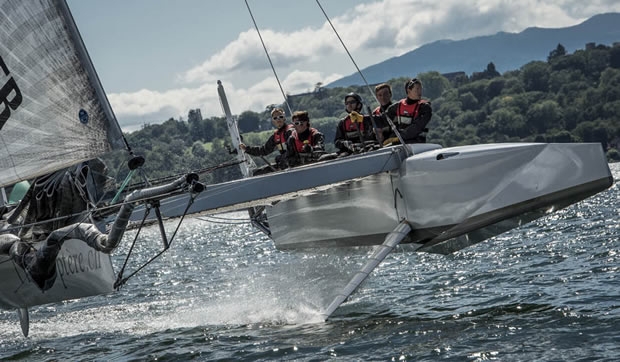
On board L'Hydroptere.ch
If the future of performance yachting and indeed some areas of commercial shipping lie in the use lifting foils, then a country among the frontrunners leading the charge into researching this is Switzerland.
With monohulls over the last decade we have seen the advent of the foiling Moths and Thomas Jundt’s air-borne three man skiff, Mirabaud LX (although it is slightly surprising we haven’t seen more dinghies, both single and doublehanded, following this path given the phenomenal success of the Moth).
Then there are developments such as the Hugh Welbourn-conceived Dynamic Stability System, with a retractable lifting foil, protruding from the leeward side of the boat, that generates righting moment. More and more DSS-equipped boats are being launched, the most recent being the Infiniti 36 GT. And update on this follows.
But much development work on lifting foils is also taking place with multihulls, which due to their lightweight are perhaps the most appropriate craft for this technology. In addition to the studies no doubt being carried out by America’s Cup design teams with their AC72 foils, leading the charge into air-born multihulls are the L’Hydroptère campaigns. We use the plural because last winter they went their separate ways. French originator of L’Hydroptère, Alain Thebault, has teamed up with DCNS to back his famous tri-foiler. This year the boat has been changed back into its ‘offshore’ configuration and after scaring its passengers in San Francisco at the America’s Cup World Series last week, is now on stand-by awaiting a weather window to make an attempt on the Transpac record from Los Angeles to Hawaii.
Back in Switzerland, the team behind L'Hydroptère.ch, along with their principle backer – Thierry Lombard, Managing Partner of Lombard Odier Darier Hentsch & Cie bank - is now concentrating more on the R&D side to its project, while also attempting to pick up local records on Lake Geneva aboard their radical 35ft long catamaran.
L'Hydroptère.ch is now one aspect of the broader Hydros campaign, announced in May. The primary goal of this is to improve the efficiency of water-borne transportation, the two main features under investigation being hydrofoil and wing technologies. So in addition to their lake boat, L'Hydroptère.ch, Hydros is also mounting a serious campaign for the Little America’s Cup, taking place in Falmouth next summer. The C-Class catamarans used in this of course feature high lift double slotted wings making them the most efficient sailing machines on the water.
Hydros' two C-Class catamarans are currently under construction at Decision SA, the first boats to be built using North TPT technology.
But in addition to the fun yachting side of Hydros, there is also a strong commercial aspect to it - data coming from their campaigns will be used in the future for the development of wind turbine blades to more efficient commercial shipping, that harnesses wind power and is foil-born.
To this end Hydros has also launched the ‘Le Défi des Grandes Ecoles’, an invitation to students and researchers from anywhere in the world to develop motorboats with foils, that use just a fraction of the energy to get from A to B compared to traditional craft.
As project founder and backer Thierry Lombard explains: "We aim to develop the technologies of tomorrow and perpetuate a pioneering spirit. The research we are doing for [L'Hydroptère.ch and ] the Little America's Cup gives us the opportunity and the privilege to add to our knowledge and develop new and innovative technologies. The Défi des Grandes Ecoles will enable us to share this knowledge with the academic world and draw attention to the issues of maritime transport, with the goal of providing both ideas and solutions that address the problems of energy supply."
So while originally the plan was to build L'Hydroptère.ch as a test bed for a round the world record breaker, L'Hydroptère Maxi, according to Project Manager Jérémie Lagarrigue their next project is now an electric foil-born motorboat.
When we went sailing on L'Hydroptère.ch recently there sadly wasn’t enough wind to get up on the foils, however this demonstrated to us one of the key elements to the design of the boat - it being 'polyvalent', ie having good all-round performance, something that often isn't a feature of foil-assisted sailing boats. Aside from ORMA 60 and MOD70 trimarans where the lifting foils in their leeward floats can be retracted (as the foil can be retracted on DSS monohulls), this is the first fully foiling boat we have come across which seems to truly work both in what the team call ‘Archimedian’ mode, ie with the hulls in the water, and when the boat has enough wind (around 16-18 knots) to be fully foiling.
Traditionally going between foiling and non-foiling modes is an awkward crossover, but one of the keys to L'Hydroptère.ch, in addition to its relatively light 1.6 tonne displacement, is the ground-breaking retractable step in each of its hulls.
We have looked at stepped hulls before – Yves Parlier’s Mediatis Region Aquitaine catamaran had a permanent step in her hulls, which resembled the floats of a sea plane. But stepped hulls have been used for decades on motorboats to reduce a hull’s apparent wetted surface area, thus minimising drag. However a problem stepped hulls have is that below a certain boat speed they create considerable drag, hence why on L'Hydroptère.ch , the entire fairing around the bow’s underside and topsides that when lowered forms the step, can be canted upward creating a fair hull for ‘Archimedian’ sailing in the lighter winds.
See the first sailing sequence in the video below to see how L'Hydroptère.ch goes between foiling and on to her stepped hulls for ‘hydroplaning’ mode.
The upshot of all this is that, slightly surprisingly for such a complex boat, L'Hydroptère.ch seems to work. As Lagarrigue says, the top speed they have hit is around 36 knots which they achieved in 20 knots of wind. Earlier this year they set a new ‘one hour’ record for Lake Geneva during which they averaged 25.25 knots and they have also set 1km and 1 nautical mile records on the lake.
Other observations about L'Hydroptère.ch is that she has a lot of beam, compared to conventional racing catamarans. While her overall length is 10.85m, her beam is 10.48m, making her platform virtually square. The similarly-long D35 for example has a beam of 6.89m without her racks and 8.74m with. In the video below Daniel Schmäh, L'Hydroptère.ch ’s helmsman and skipper explains that this is due to requiring enough separation between her hulls to use the foils.
L'Hydroptère.ch is also the most complex boat we’ve ever sailed on, certainly for her size. Lagarrigue explains that this is because she is a ‘laboratory’. “It’s so we can explore the different ways we can control the boat, which is why we can move the foils in three dimensions, we can adjust the rudders in two dimensions and we can change the weight and many things on the boat.”
According to Lagarrigue if someone asked them to do come up with a larger version or an offshore version of Hydroptere.ch they would certainly oblige, but at present their objective is focussed on investigating how to improve the efficiency of their craft. “We compare all the information from this to build a new boat, a boat for the future, an electric flying motor boat. And there are still plenty of other ideas to explore after the experiments we have made on this boat. We have to explore all the sustainability systems that we can use to produce energy with a view to working on the electric, aero and hydrodynamic systems.”
Hence why the sailing teams are not just sailors – although most are accomplished in this field, Lagarrigue for example is a top F18 sailor and famously finished second at the Worlds in 2008 as crew for Franck Cammas. He, Daniel Schmäh, Stéphane Dyen (brother of French 49er Olympian Manu), Davy Moyon and Gaël Ledoux, who form the sailing team, all graduated from Switzerland’s world renowned engineering college the École Polytechnique Fédérale de Lausanne (EPFL), which was the engineering partner of Alinghi for Ernesto Bertarelli’s America’s Cup campaigns.
In the video below we look at L'Hydroptère.ch sailing (okay, this is stock footage and not from the day we were on board) and get a guided tour to her systems from skipper/helm Daniel Schmäh.
To see the video below in its full screen glory, click on the bottom RH button in the viewer.
NB: This video is 10 minutes long and may take a few moments to load...
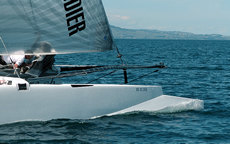 |
|
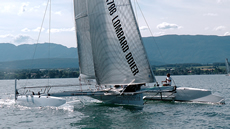 |
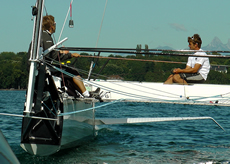 |
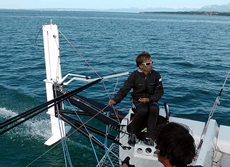 |
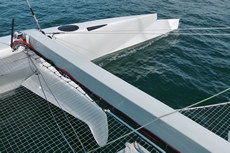 |
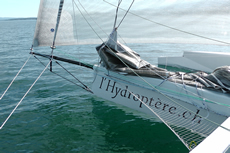 |
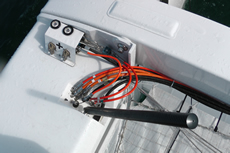 |
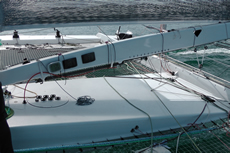 |
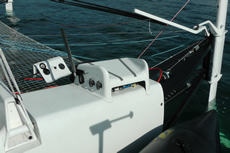 |
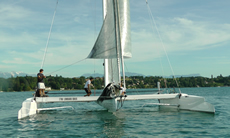 |
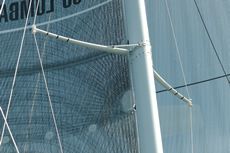 |








Latest Comments
Add a comment - Members log in